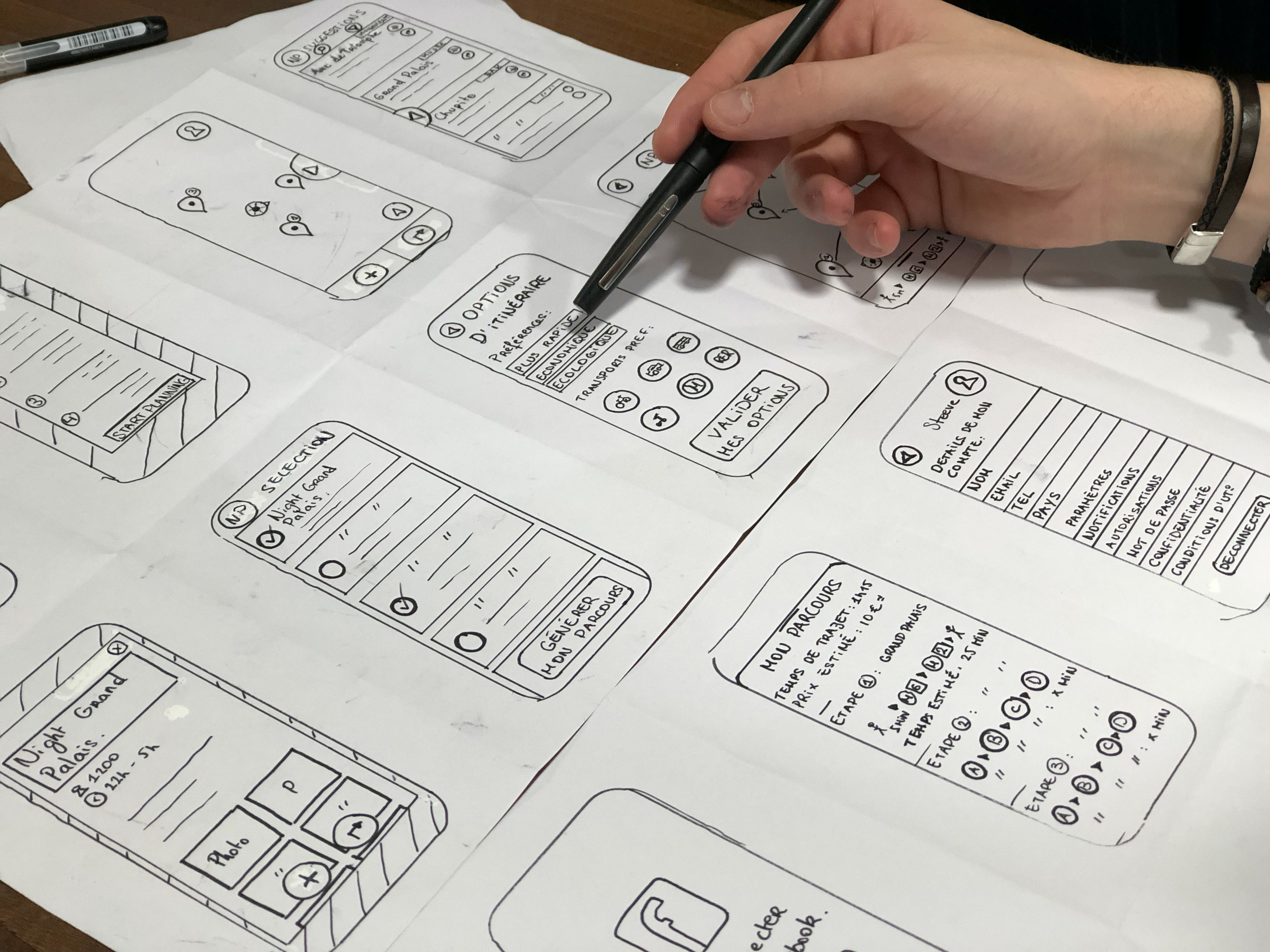Advanced entrepreneurs, product managers, and marketers know that working with existing customers is easier than acquiring new ones. But what are the ways to retain, engage, and motivate users to consistently return to your app? What customer retention strategies in healthcare should we choose for increasing user retention?
In Digital Health, it may seem that people should naturally return and engage, as their health often depends on the product. However, this is just a presumption, as people are naturally inclined to procrastinate and find reasons to skip a workout or not do an exercise today.
That’s why it’s important to engage and remind everyone of the importance and value of your app, especially when it comes to healthcare customer retention.
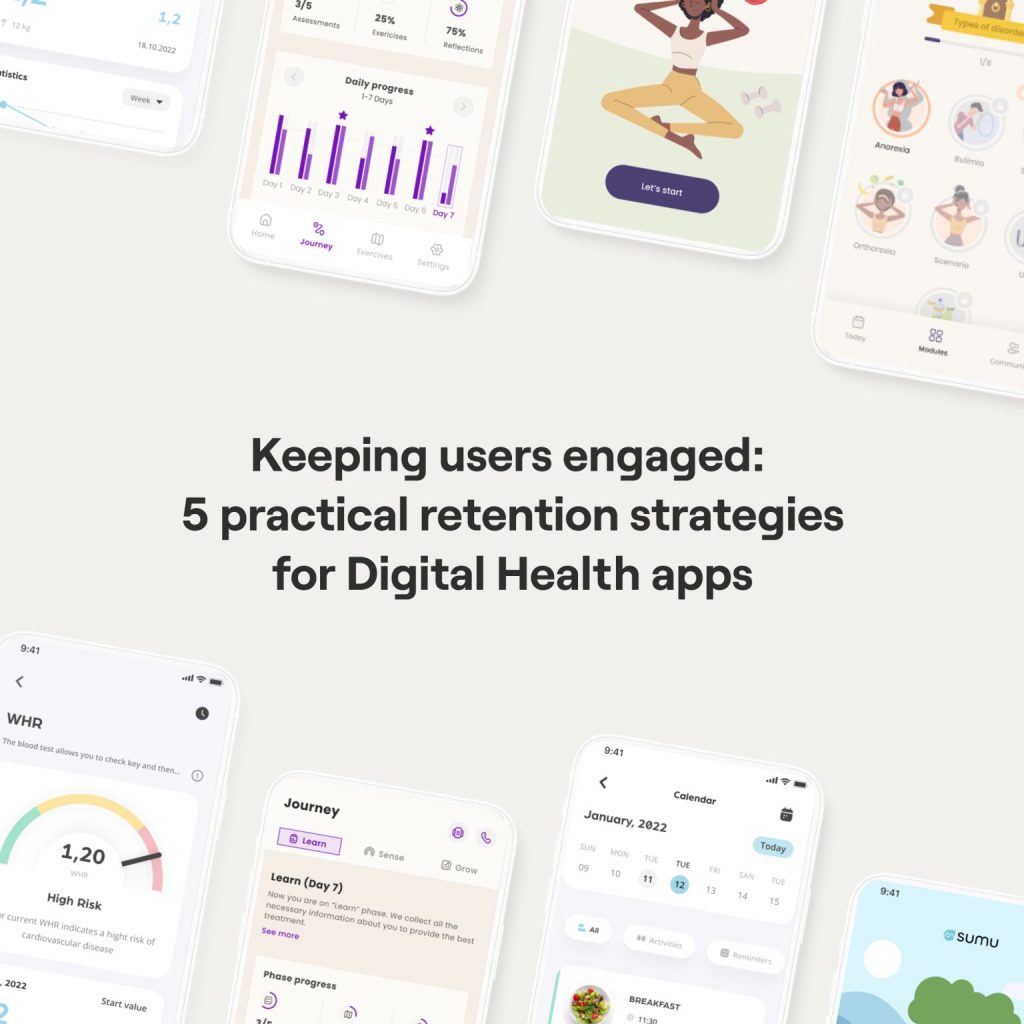
Recently, we decided to revisit our most effective customer retention strategies in healthcare that we have developed for Digital Health applications. We want to share this experience with you today.
Additionally, it’s essential to remember that the higher the retention, the higher the app’s LTV (Lifetime Value). For example, research shows that a 5% increase in the customer retention rate can increase profits from 25% to 95%.
We have confirmed this even in our own experience when we developed various Digital Health products. We were able to achieve increased metrics using user-oriented processes. We wrote about this approach (UX/UI, process and development methods) at the link below.
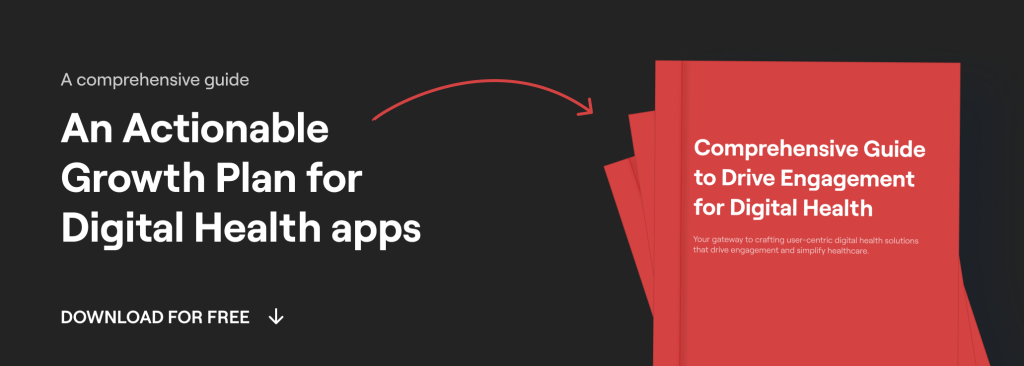
Download Free Actionable Insights to Grow your Digital Health app
1. Let’s begin with onboarding
According to research, 25% of users typically only use an app once.
Some users uninstall the app once they begin to experience onboarding difficulties or lose faith in it due to improperly placed commercial barriers. Unfortunately, some even pass away.
What’s the cause? Rarely do clinical specialists have the background, resources, or incentives needed to design a user-friendly health app.
When it comes to apps that help to cope with diseases or maintain a healthy lifestyle, then trust and first impressions are of paramount importance. This is very important for retention in Healthcare apps. After all, the user understands that he will have to use such an application very often and for a long time because of the specifics of the disease or understanding that exercises should be performed weekly to maintain good health. It means that you should build trust with your users from the first touchpoints.
How, therefore, can we begin to gain the users’ trust during onboarding?
If you Google it, you’ll come across many articles with common tips on giving users a seamless onboarding experience. Keep it brief and exciting; utilize a progress bar; and don’t forget the “skip” button are all things you’ll undoubtedly see. This is unquestionably true, but we want to discuss less obvious aspects with you today.
According to research among users of health apps, 43% of users removed the app after downloading it once they discovered how much personal information was needed during the onboarding stage.
Sharing lots of personal data requires much efforts and cause privacy concerns, which lead to mistrust and users’ drop.
Therefore, be sure that your product genuinely needs the data it is requesting in order to deliver its core value. Keep in mind that not all of the marketing data is appropriate to store in databases. It is preferable to prevent user strain, otherwise we just won’t achieve a high level of healthcare customer retention 🙂
The following are some brief tips on how to perform better:
1. Minimize the use of advertising messages.
2. Do not require a lot of personal data on onboarding. 2–3 questions are enough.
3. Include links to comprehensive studies or trustworthy sources to demonstrate accurate information.
4. Create an emotional bond with users by using either known characters (if the audience is children) or more frequent depictions of real people and their faces (if the audience is adults).
5. Offer social proof in the form of statistics and expert reviews (even if the end-user is a child, parents will likely want to make sure their kids only use reputable applications).
6. Remember to use the “skip button” 🙂

In general, to create engaging onboarding, you need to actively collect feedback from users already at the development stage. But it can slow down the development itself if you don’t use the right processes.
2. Apply gamification for improving user engagement
Let’s talk about another widely discussed topic – gamification.
It is a proven strategy to boost engagement and affect retention in healthcare apps. However, many people get it wrong.
When they hear the word “gamification”, they start to imagine a childish interface with villains and good rescuers. However, incorporating gamification into your product doesn’t mean that you should turn your whole app into a game. It can be the game but in the context of health apps, gamification usually means interactive elements like points, prizes, and quizzes to help users build habits, return to your app, and improve their outcomes.
Let’s explore these two options.
1. Create a fully gamified health app.
This option essentially takes gamification to the extreme by proposing to turn the entire product into a game.
This approach is quite risky and requires a thorough analysis of the market and target audience, as it may not be well received by users. However, if implemented correctly, it can be advantageous.
One example is our internal platform that engages patients in their treatment through a compelling story and gamification mechanics. The process is simple: instead of just following a treatment plan, patients embark on a mini-quest based on an engaging story and complete tasks outlined in their treatment plan.
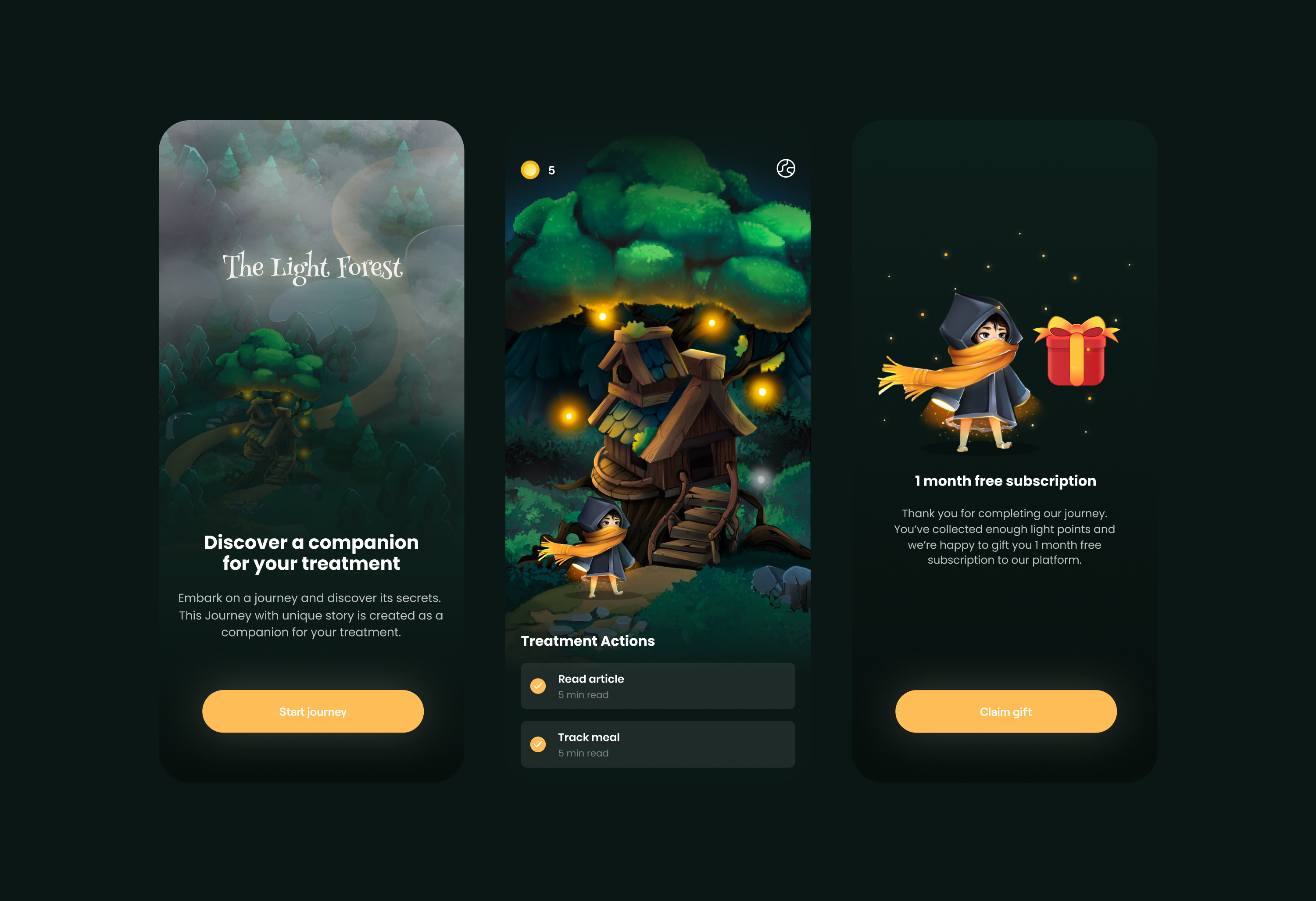
The second choice is more frequently employed and is appropriate for any digital health app:
2. Add unique gamification elements.
It is a fantastic technique for increasing user retention because it can be applied to any health app and can be used in all ratios and combinations.
Let’s examine the elements and instances that are the most effective:
2.1 Rewards such as points, badges, and other kinds.
Implementing a rewards scheme will encourage customers to stay using your app because the promise of better health results is insufficient. This tactic is frequently used with great success in mobile games where you may give players extra lives or in-app currency, but it is more difficult to apply in digital health apps. However, prizes can be as modest as a badge or even just a set of redeemable vouchers.
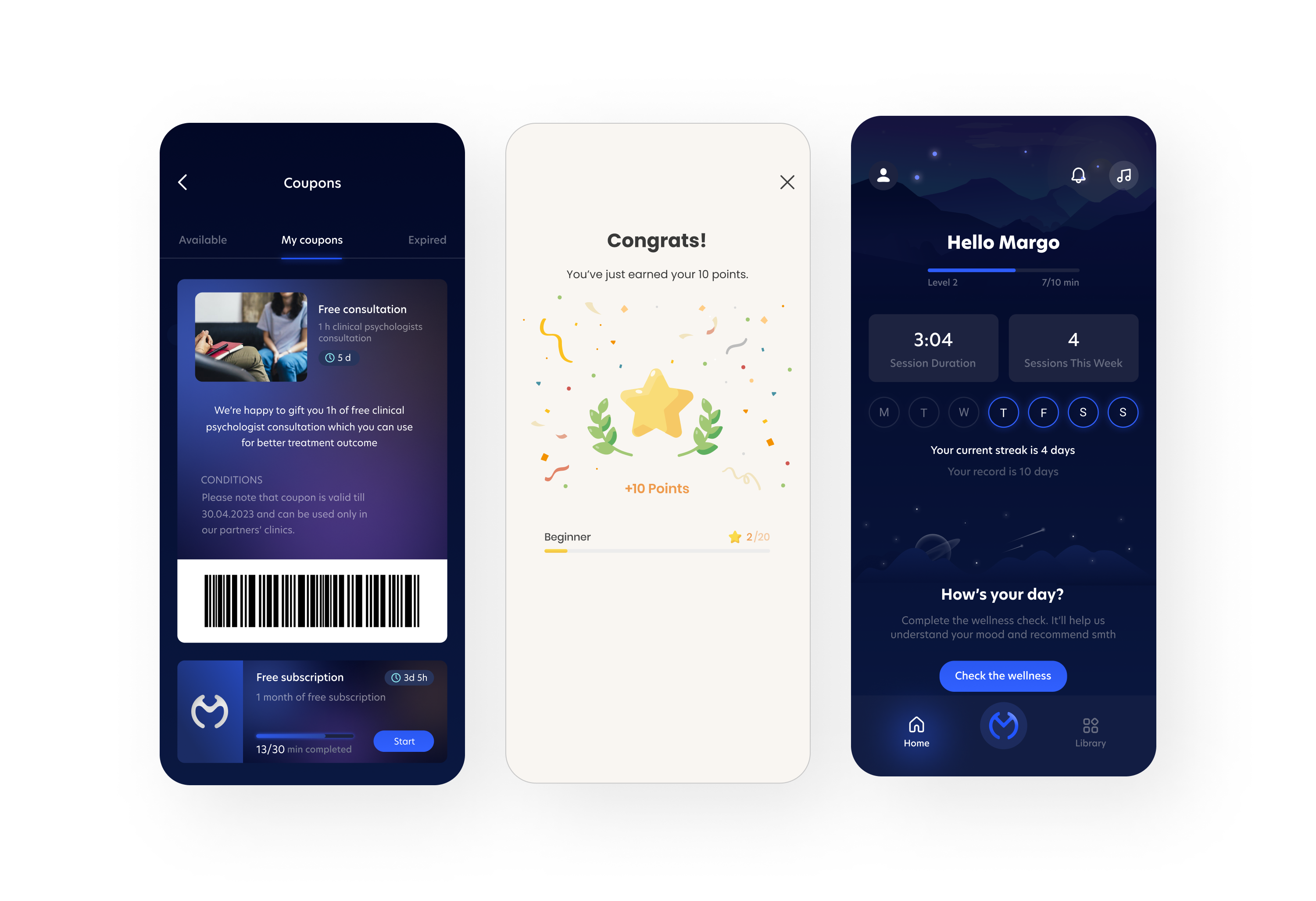
2.2 Competitions between friends and leaderboard.
When you’re doing anything with someone else, it automatically becomes simpler. You can aid one another as you complete the assignments. Additionally, competing against someone inspires people to take on the challenge and succeed.
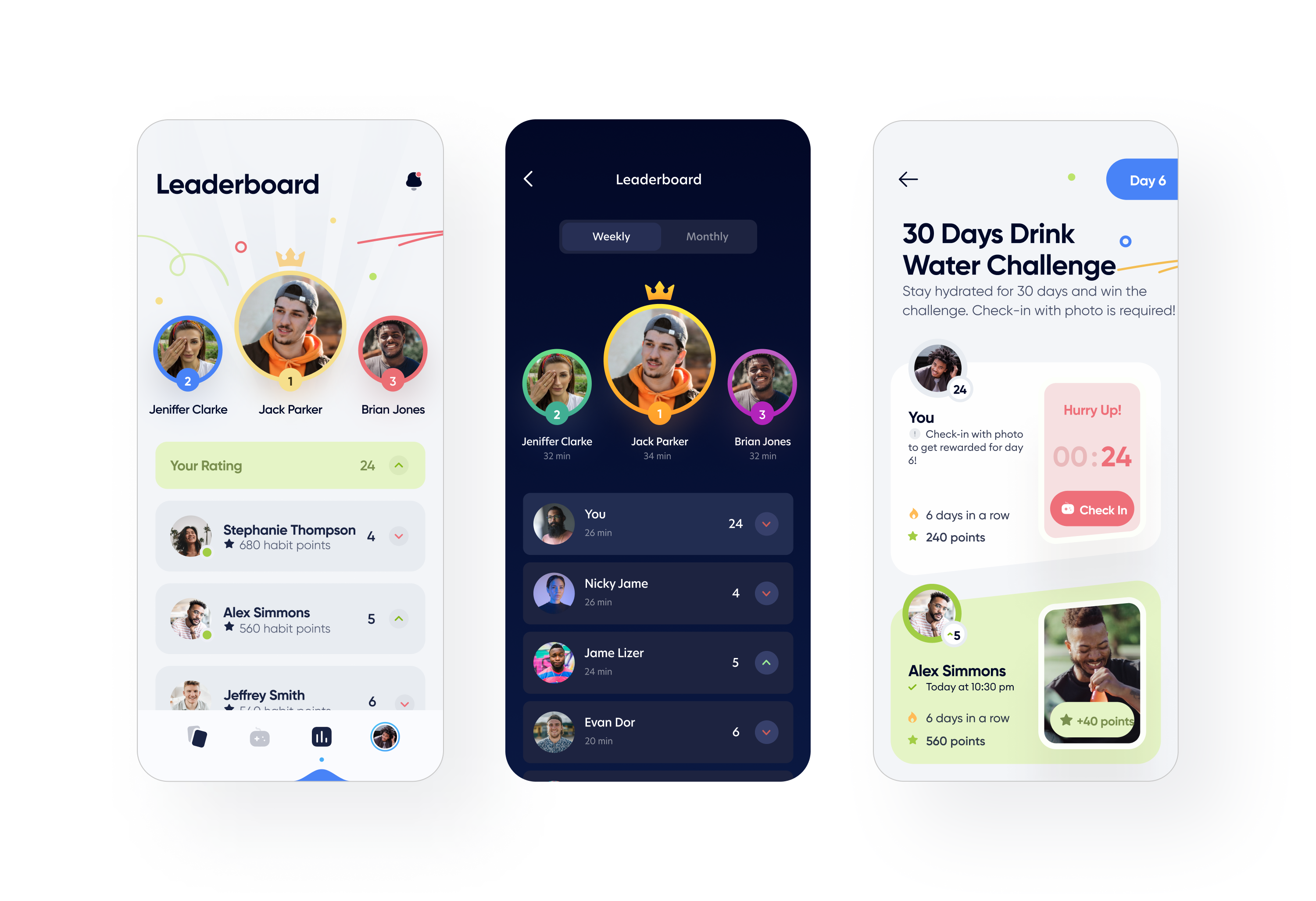
2.3 Content presented in a gamified way.
If your treatment plans incorporate educational material, you might offer it as a journey with quizzes and points.
Look at the example of an app below that recommends therapy for patients with eating disorders.

Remember that it’s not necessary to implement all the elements. Mental wellness apps use challenges, quizzes, rewards to make users’ way to obtaining emotional wellbeing more interactive and engaging. Fitness apps use badges, like those for steps you walk, and social engagement to make users challenge their friends and motivate them to reach their fitness goals in a fun way. And it works because the human brain is constantly seeking new challenges.
We wrote a whole article about gamification that thoroughly explained how it was applied to an app designed to aid people with eating disorders. You can apply some of the concepts described in the article to your app to see how gamification contributed to increasing user retention and other metrics.
3.Provide efficient assistance and communication
This point I’d like to start with real story of one of our partners. Our friend Michael was having difficulty in his digital health app with patient retention. Communicating with users, he noticed that they lacked motivation and meaning. They don’t feel like they’re doing anything meaningful and their focus is lost.
It would seem that digital health apps shouldn’t have any issues with motivation. However, the problem still exists; it’s only that it no longer revolves around reasonable motivation. Here, it’s essential to establish the conditions that allow the user to derive enjoyment and purpose from routine activities.
What can we do to assist users with this?
1. Provide accurate and timely information
It involves keeping the app up-to-date with the most recent medical research and suggestions to guarantee that users can access accurate and current information regarding their health condition or concerns.
Additionally, you could offer educational resources. Users can learn about the state of their health, control symptoms, or alter their lifestyles to improve their health with the use of articles, videos, or interactive tools.

2. Create a user community to facilitate communication and assistance
First, keep in mind that humans are, by nature, social beings. Social media has become a worldwide sensation for a reason, and if an app can foster the same sense of community, it will encourage users to connect and use it again. Create a sense of community and invite involvement by setting up forums or a best-of list.
Let’s use one of our recent cases as an example right now. Microshift is an application in which you listen to a meditative track every day during breaks and share your current mental state.
The app incorporated the concept of circles. The essence of the feature is to create an emotional background: we encourage people to listen to content and communicate emotions from it to each other in the digital space. People used to gather near the fire long ago, but now we can do the same, even at a distance between us.
This collaborative approach and emotional connection to other users solve the problem of improving user engagement and help users better manage their condition.
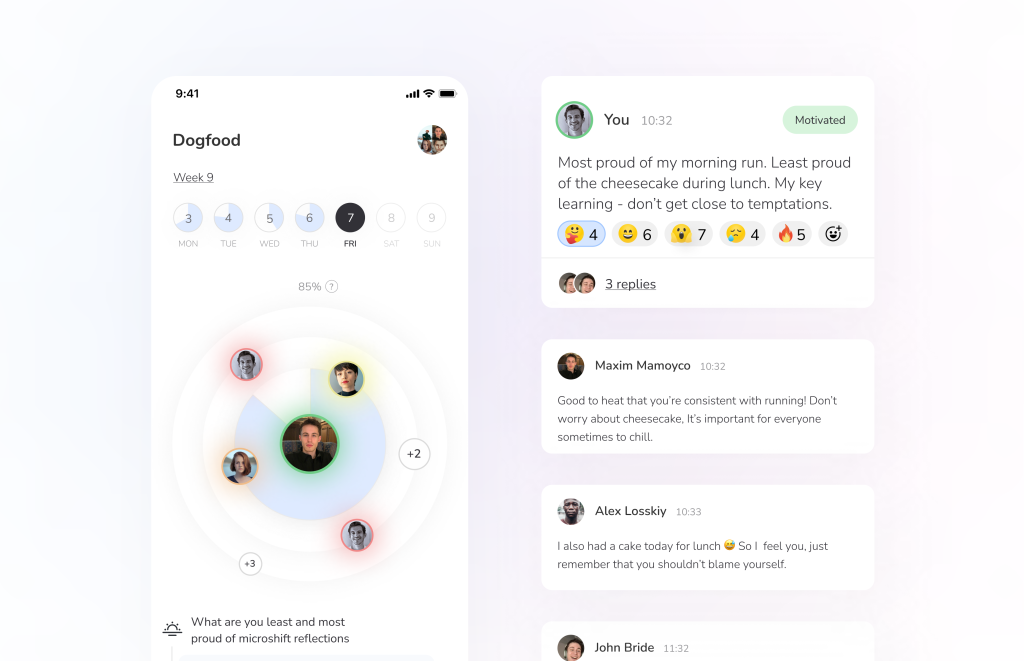
4. Make the app unique for each target audience
Can targeting particular user groups help enhance retention for your healthcare app if it targets several user groups?
Targeting specific user groups can definitely help boost healthcare consumer retention if your app caters to multiple audiences. By tailoring features and interfaces to different segments, you’re more likely to keep users engaged and coming back.
Consider the range of people your app is intended for and the many use cases you may develop for each.
1. Depending on the patients’ age, diseases, and level of athletic training, there may be divisions within the group of patients.
For athletes, you might offer individualized training schedules and dietary recommendations to assist them in achieving their fitness objectives. You may concentrate on fall prevention and mobility exercises for the elderly. You can provide tools to help patients with chronic diseases track their symptoms and manage their medication.
And all of this may be included within the framework of a single application, for instance, with a longevity-focused theme.
2. Target segments can also be divided using a unique interface tailored to each user group (B2C, B2B – and even within B2B, there is room for division).
For instance, we created various user interfaces for students, psychologists, and schools in the Allbry app. 10,000 students have used this practical app, with over 100 contracts with Swedish schools.
Both segments of the target audience are interested in using the application daily (every day) due to the value of understanding and obvious segmentation.
Students can see chats and appointments.

And schools and psychologists can see general and particular statistics on student success.
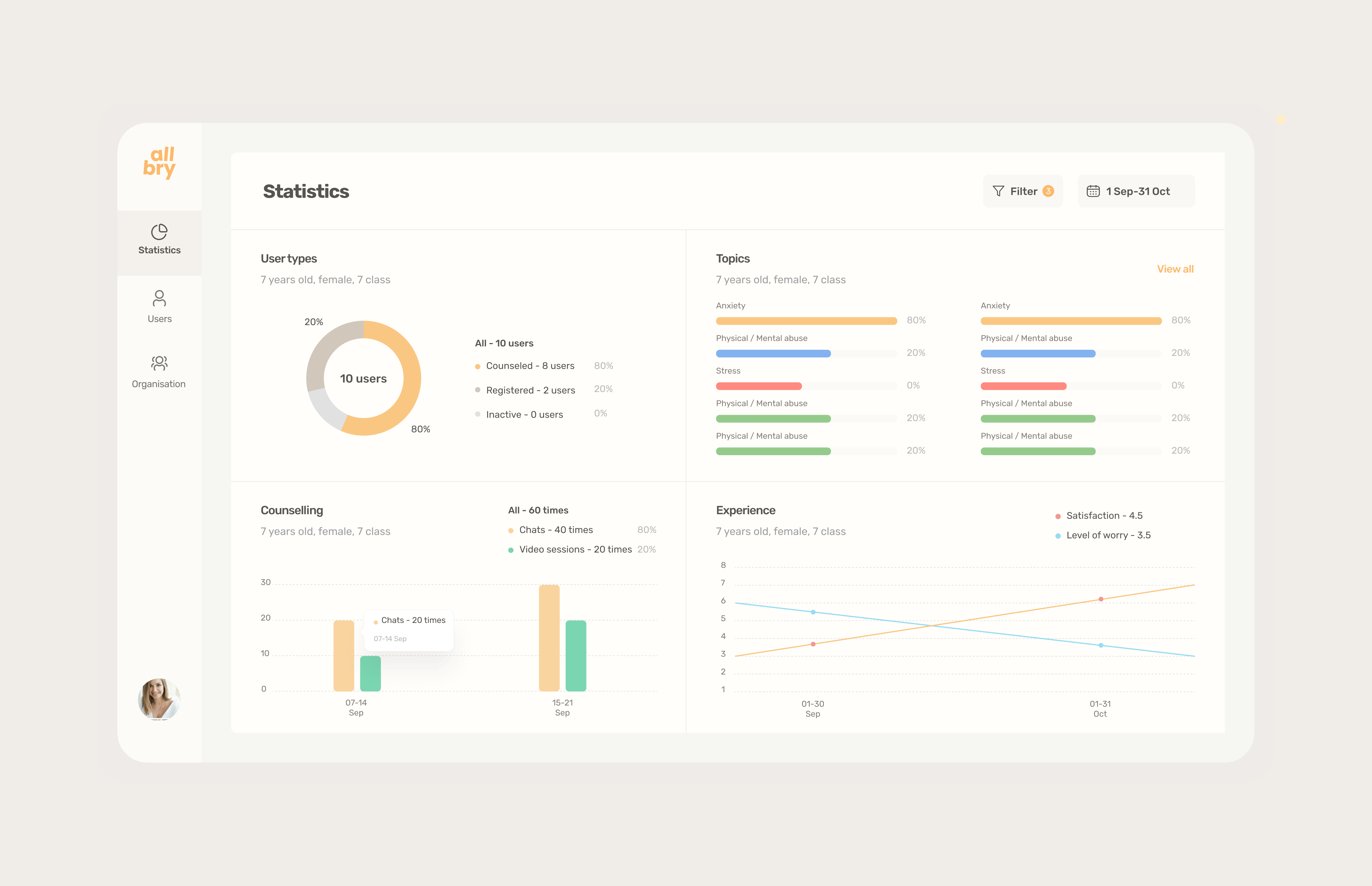
5. And the last of the retention strategies: Maintain an appropriate amount of reminders
Great power requires enormous responsibility.
It is the perfect way to define notifications because they are a powerful tool—but only when used correctly.
Since push notifications are often cautious, let’s illustrate the point here using the real story from our experience.
Once upon a time, a woman named Sarah wished to take charge of and easily overcome her tension and anxiety. She did this by downloading the Sensae app, which uses AI and a medical gadget to measure her stress and anxiety.
When Sarah first opened the app, she was greeted by a form requesting her to address her current issues.
The software reminded Sarah to wear her Sensae device and check in on her mental health over the following few days by sending her reminders.
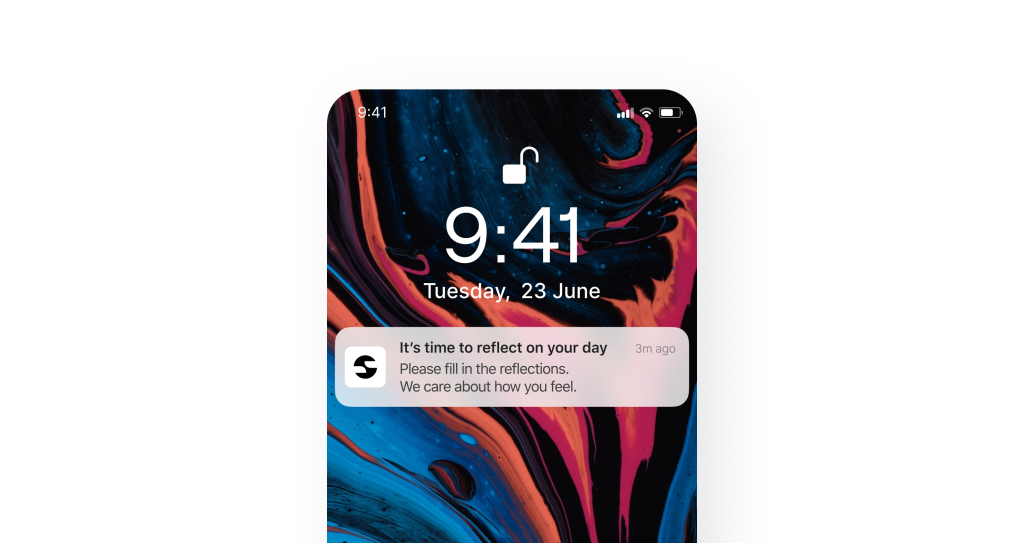
The app started sending Sarah daily push alerts as soon as she began to see results, complimenting her on her accomplishments and urging her to keep going. The app also offered tailored recommendations based on her success using AI.
Once Sarah had a difficult day at work, so she neglected to finish the breathing exercise.
She received a helpful push notification from the app offering her to continue working out in the future and providing encouragement and support to keep her on track.
Sarah gradually increased her app usage and started investigating its additional capabilities, actively browsing and sifting through the same dashboards with statistics.
Sarah was able to accomplish her goals and live a healthier lifestyle with less stress and worry thanks to using the Sensae app and receiving its push notifications. She loved the ease and convenience of receiving push notifications directly to her phone and felt supported and driven by the personalized advice and reminders provided by the app.
Push notifications are the simplest and most well-liked method to boost healthcare app retention. However, the majority of individuals either disable or ignore push notifications.
Additionally, since users are exposed to so many of these messages daily, none of these is seen through their banner blindness.
You simply need to pay attention to the headline and opening sentences, which accurately capture the message’s substance and significance.
For instance, it’s crucial to set up reminders that meet the user’s medication schedule but aren’t too frequent or bothersome if the app is intended to remind users to take their meds.
What additional notification options are available?
1. Reminders to keep a food and activity journal every day.
2. Reminders to meditate every day.
3. Reminders to do our everyday activities.
4. Reminders to stay hydrated all day long.
The effectiveness of push notifications is determined by the user journey as well as the overall app design. Without a good understanding of the healthcare industry, regulatory framework and the characteristics of the target audience, push notifications will not work a second or third time. If a user does not understand the UX or thinks that the product is only trying to make money off of them (due to the frequency of push notifications), they will leave.
Therefore, it is necessary to have a clear understanding of how the UI/UX design should work, what user path we should build (including notifications), and how to do it in a way that shows care and value. To achieve this, there is an approach called User-Centred Design, which allows to create solutions that are effective, efficient, and enjoyable for end-users, ultimately leading to better outcomes in healthcare.
For keeping track of emerging technology trends in healthcare industry, you can explore our selection of 100 resources (books, guides, websites, and influencers) about User-Centred Design, Product Management, UX, Technology, Healthcare market trends, and Product Marketing.
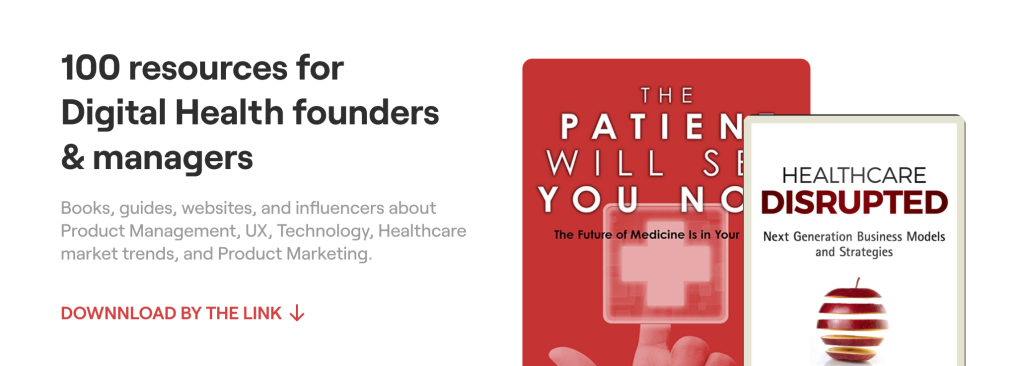
Download List of 100 resources for digital health startup founders & managers
Remember that increasing user retention is an ongoing process
Retention never ends! It’s an ongoing process that requires your team to pay attention to user analytics throughout the user journey.
We discussed the main strategies for increasing retention. In some cases, all of them can be used, but it depends on the app specification.
Pay close attention to your data to understand where patients are exiting your app, which steps or features lead to reducing user churn, or at which step in their care they tend to lapse. When you know this, you can not only tweak the app to fix these bottlenecks but reach out to your users to re-engage them.
If you need to release a product or a critical feature on a tight schedule or you want to receive digital health product expertise — Let’s discuss how we can help ensure that your product brings real benefits


